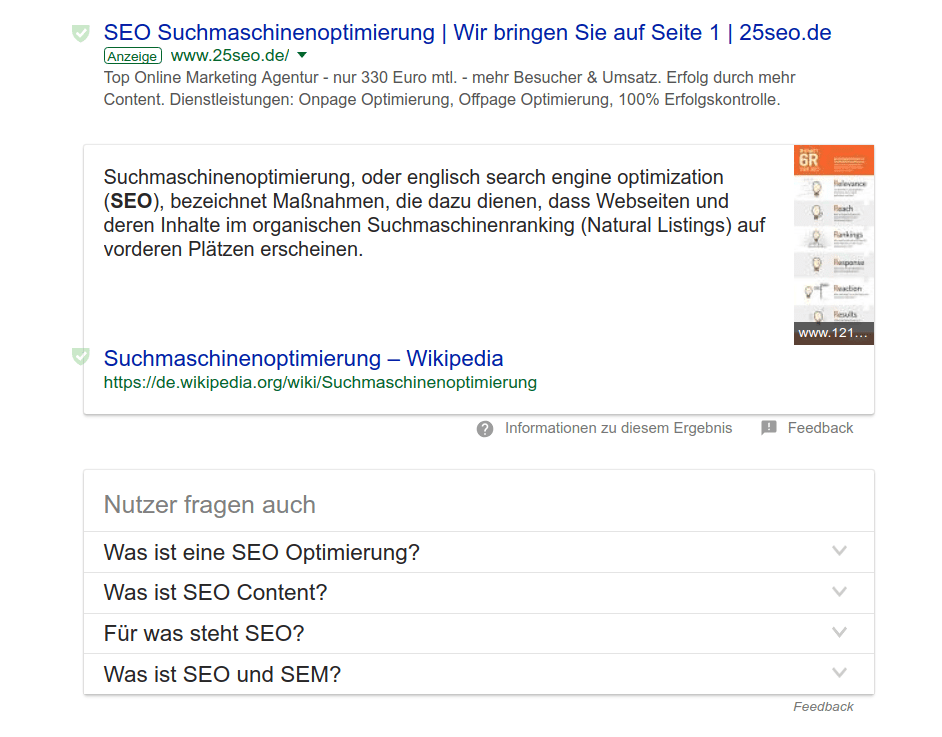Content SEO 2019: These 5 SEO trends you need to know!


Every year... At the start of the New Year, there are numerous tips and tricks on search engine optimization and content marketing. Of course, the wheel does not have to be reinvented. Many Google ranking factors are already known, others will increasingly come into focus in 2019.
Basically, it can be said that Google continues to successfully work on user satisfaction. Keywords and links alone are no longer enough. This is made clear by buzzwords such as cornerstone content, link learning and user signals.
In the following, I'll tell you which criteria you should focus on, what to look out for in content SEO 2019 and how to improve your Google ranking with simple steps!
{{divider}}
1. the most important Google ranking factors 2019
The fact is, user behavior has changed with the increase in new functions (voice search, local pack, etc.). The average Internet user searches in a more differentiated way today than in the past.
Instead of individual, generic search terms, entire phrases or sentences are used as keywords. The trend is unmistakably toward spoken language. Instead of "Date of birth Barack Obama", people ask or type in "When was Barack Obama born?
As Google continues to move toward user experience, search intent - the intention behind the search query - is critical to website ranking.
One reason why the search giant no longer evaluates websites "merely" according to keywords, but includes many other criteria. An algorithm was developed specifically for UX metrics: RankBrain, an AI that is constantly learning.
1.1 How does Google RankBrain work?
Simplified explained: RankBrain evaluates your clicks and dwell time on pages and determines the Google ranking in the search hits.
For example, you and your family are planning a small buffet for Christmas. Consequently, you google the term "prepare buffet at Christmas":
- The 1st hit in the SERPs is a forum link titled "Christmas buffet, when and what to prepare".
- The 2nd hit is a collection of recipes: "Buffet - the best recipe ideas".
- The 3rd hit is right up your alley and what you're looking for, "Buffet at Christmas: the ultimate preparation checklist".
While you click on the 1st link and leave the page right away, you notice the 3rd link in the organic search results and calmly click through the content. During this time, Google clandestinely measures how fast you left the 1st page and how long you stay on the 3rd page.
The results are saved. The next time you make a similar search query, Google will display websites similar to page 3 in our example in the first place.
1.2 What are the TOP SEO trends 2019?
As user satisfaction continues to come into focus with other factors such as readability and usability, OnPage SEO continues to gain importance. It is clear that elements such as short permalinks, fast loading time, unique content, title & meta description and alt TAG are relevant for the visibility of websites. What is new, however, is that the following points are increasingly evaluated by Google:
- Quality Content (Premium Content)
- Authority, Expertise & Trustworthiness (E-A-T)
- User Experience
- User Signals & Social Sharing
Cf. Google's Quality Rating Guidelines
{{divider}}
2. SEO checklist for 2019 - 5 ranking factors that are guaranteed to push your page to the top.

So far, so good.
But which Google ranking factors can you use?
What SEO trends will you use to improve your visibility online?
And what should you look for in all of this?
Below, I'll give you an overview of the 5 most important Google ranking factors in 2019 and tell you how to implement them simply but effectively.
2.1 SEO Quality Content
Actually, it's not a secret. But it can not be repeated often enough, because some do not want to get it: High-quality content is one of the TOP SEO ranking factors at all next year and the year after that, and for much longer.
And: This quality content must be search engine optimized - otherwise no one sees it or only the wrong people see it! It is therefore more worthwhile than ever to invest in high-quality SEO texts with added value. Writing SEO texts for readers and Google is not a contradiction. Quite the contrary.
2.2 Content Clustering & Siloing
With the content clustering method, you prove yourself as an expert in your field. The idea here is to create topic complexes that comprehensively cover a specific topic. Known synonyms for this method are siloing, independent content, holistic content, or cornerstone content.
2.2.1 How content clustering works
- You write a main article (= pillar content) that informs comprehensively about the topic, but does not go into too much detail. An overview article, so to speak. Example: "Shoe care - everything you need to know".
- Based on the pillar content, you create so-called cluster pages. These are side articles that deal with niche issues and details. Long-tail keywords are particularly suitable for this: although they have a lower search volume, they are more relevant. About 10-15 cluster pagesare recommended. For example: "Must-have products for shoe care", "Shoe care products in the test - these are the best care products for shoes" or "How to care for leather shoes properly - this is how it works!
- Once the content is created, you link all the secondary articles in your main article using the siloing method. This way, the authority of your home page is systematically strengthened with the main article.
Voíla - now you have a topic silo with useful content and sensible internal linking structure. Absolutely worth its weight in gold!
2.3 Positive User Signals
Google's RankBrain strives for personalized content. Each user receives an individual search experience that is precisely tailored to their search and usage behavior. Google analyzes user signals such as: Visit duration on the website (dwell time), bounce rate, CTR (click rate) and return-to-SERP rate (also back-to-SERP rate).
This data is intended to provide conclusions about how relevant your page is to the user's search query.
By the way, social signals (likes, shared content, comments, etc.) are a special form of user signals and are included in the ranking calculation.
Very likely equally important: linkless backlinks (brand mentions) - mentions of websites or brands in a text are valued similarly to normal backlinks, as they provide a positive reputation.
2.3.1 How can user signals be improved?
By turning a few screws on your website and optimizing it in a user-friendly way. 4 points are particularly crucial:
2.3.1.1 Content optimization
Not only the right keyword fields are crucial, but at least as much the high quality of the content. You should also think about different content formats. For example, videos increase the time spent on websites many times over.
2.3.1.2 Technical optimization
The loading time of your website should be under 2 seconds to be considered optimal. Both on the desktop (PageSpeed) and mobile (MobileSpeed). Anything over this will cause impatient visitors to bounce right back. Also, content should not be overlaid by menus or other gimmicks.
Also to consider: SSL encryption (switch to HTTPS) - preferably still with a visible SSL certificate on the website. This fuels the trustworthiness.

2.3.1.3 Meta data optimization
Unfortunately still neglected: Title-TAG (page title) and Meta-Description (page description) are your flagship on the Internet. They are the first thing readers and customers come into contact with. In addition, a meaningful description ensures that the right visitors reach your website.
2.3.1.4 Mobile website optimization
Google has long since confirmed that mobile-first indexing is a ranking factor. This means that the mobile version of your website is indexed. And it is also used for ranking, the desktop version plays a subordinate role. This has not only been the case since yesterday.

In plain language: Google makes sure that your website can be used quickly and easily, especially on mobile devices (smartphones, tablets). For this purpose, the algorithm distinguishes between desktop and mobile user signals. If these indicate a negative UX and usability, the ranking of the entire website is worse. The mobile website version is therefore your primary version for Google ranking.
Modern CMSs therefore have a responsive design so that the content is automatically tailored to the end device when it is played out.
2.4 Featured snippets

Next to quality content, the buzzword for content SEO 2019 par excellence. Sounds a bit paradoxical, but the position 0 in the search results is the most sought-after place. In fact, anyone who ranks well and answers a search query directly and accurately can end up in the knowledge box. No less promising is a positioning in the PAA box (People-Also-Ask box), which highlights your website in a prominent position.
2.4.1 How can rich snippets be optimized?
It is worth treating W-questions as longtails and incorporating them into the body text. This is no problem with a structured text and usually happens intuitively. Use trigger words so that the search engine recognizes the answers more easily. The whole thing has another advantage: You rank not only in the desktop SERPs, but also for queries via voice search.
Regional businesses and service providers should focus on the local snack pack. It plays a significant role in mobile search and is a local competitive advantage that unfortunately often goes untapped.
Unfortunately, this also applies to the highlighting of website elements with structured data (for example, using the Google Data Highlighters). They help Google to properly understand the content and context of your website. They are also used to display rich snippets.
2.5 High-quality backlinks (link earning)
Backlinks have of course not become obsolete and are not less valuable. The focus has merely shifted. They are still among the ranking factors - even in 2019. The most important aspect of backlinks is quality, according to the motto: class instead of mass. Therefore, the buzzword link earning instead of link building has spread in the SEO scene.
Links from sites with high authority are especially valuable. For example, from Wikipedia or relevant educational institutions (also known as edu-links).
2.5.1 How do I get high-quality backlinks?
There are different ways to get external links that are really relevant to your site.
For example:
- Search for link lists and have your article linked. SEO tip: Enter "topic + link list" or "topic + this week" in the search box.
- Submit your website to relevant industry and web catalogs
- Write a guest article for a high-profile blog in your field of expertise
- Conduct interviews with experts from educational institutions
- Comment on other expert blogs in your topic area with meaningful statements (nofollow links are good too!).
SEO tip: Speaking of links, outbound links - links from your site to another website - are also part of a natural link profile. This shows how well you know the subject when you link to other specialists or influencers.
{{divider}}
Conclusion: cheers for the user experience
Remember: user experience and user satisfaction are at the top of the content SEO checklist in 2019. So it's high time to fully realize the potential of your website and benefit from a better Google ranking.
With the TOP SEO trends 2019 presented here, you are well prepared for the new year!
Keyword SEO: In our Content Marketing Whitepaper you will learn how to create SEO-appropriate content that not only convinces Google but also potential new customers. And here you can download it for free:

Content SEO 2019: These 5 SEO trends you need to know!
contentbird.blog






